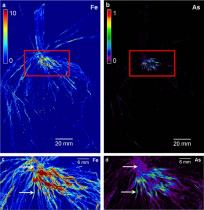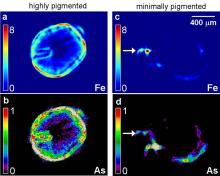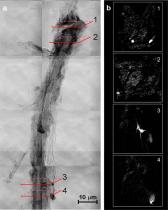
Arsenic (As) is a human carcinogen and natural contaminant of soils world-wide, but in south and southeastern Asia it is a catastrophic groundwater contaminant. While arsenic exposure via drinking water is well-documented, we are only beginning to understand the magnitude of chronic arsenic exposure from contaminated food products like rice (Oryza sativa L.). Upon soil flooding during rice cultivation, arsenic in soil is mobilized, taken up by roots, and accumulated in the edible portion of the grains. The accumulation of arsenic in soil as a result of arsenic-laden irrigation water is a potential ticking time-bomb for much of the world that depends on rice.
While it is clear that arsenic is transported from soil or irrigation water to the edible grain, the processes at the root interface influencing arsenic uptake are unresolved. As rice plants deliver oxygen to roots via aerenchyma, O2 diffuses to the soil proximal to the roots (an area termed the rhizosphere) and dissolved Fe(II) may be oxidized and precipitate on the exterior of rice roots (termed Fe pla

que); this Fe oxide rind is thought to be an important barrier to As uptake by rice. While the presence of Fe plaque may limit root absorption of arsenic, the absence of Fe plaque may enhance absorption; however, the distribution of Fe plaque and its effect on root absorption of arsenic species is not well characterized, limiting our understanding of its role (if any) in influencing nutrient/contaminant uptake.
In a recent paper published in Environmental Science and Technology, researchers from Stanford University and SSRL have used hard X-ray techniques to elucidate the controls of Fe plaque on arsenic uptake. They grew rice plants under controlled conditions in As-contaminated soil and used a combination of techniques—X-ray fluorescence imaging, µXANES spectroscopy, transmission X-ray microscopy, and TXM-based tomography— to characterize the distribution of Fe and As species on rice roots. Their investigation shows that variable Fe plaque formation affects As entry into rice roots and, counter to the current paradigm, is not a root ‘interceptor’ of this toxic element. Arsenic is not exclusively associated with Fe plaque in the rice root system, and Fe plaque does not coat many of the young roots or the younger portion of mature roots (Fig. 1). On roots with Fe plaque, As and Fe were strongly co-located around the root; however, maximal As and Fe were dissociated and did not encapsulate roots on roots with limited plaque (Fig. 2). Transmission X-ray microscopy (Fig. 3), revealed smaller accretions of As and Fe more homogeneously distributed within the root tip (Fig. 3 b1-2), with larger accretions on the interior and exterior in patchy distribution near the root base (Fig. 3 b3-4).
Their study illustrates that variable Fe plaque coatings affect As behavior in plant uptake of arsenic. Roots with Fe plaque have As(V) co-localized with Fe and an exterior coating of As(III). However, the presence of As(V) on the root interior (i.e., within the cellular structure of the root) indicates that As(V) is not exclusively reduced to As(III)or arsenictris-glutathione once on the root interior. In roots without Fe plaque, As(V) and As(III) have little restriction to apoplastic entry. Given the lack of Fe plaque in many of the roots, especially the fine roots, their study shows that Fe plaque might not be an effective barrier to As uptake by rice roots (at least for systems with limited Fe(II) available for plaque formation).
A. L. Seyfferth, S. M. Webb, J. C. Andrews and S. Fendorf, "Arsenic Localization, Speciation, and Co-occurrence with Iron on Rice (Oryza sativa L.) Roots having Variable Fe Coatings", Environ. Sci. Technol. 44, 8108 (2010)





